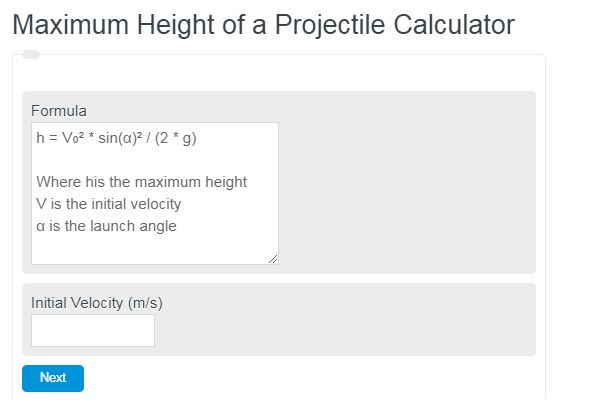Enter the initial velocity and the angle of the launch of an object in projectile motion (assuming no air resistance) to calculate the maximum height of the projectile. This calculator can also evaluate the initial velocity or launch angle, given the height and the other variable.
- Horizontal Projectile Motion Calculator
- Free Fall Calculator
- Escape Velocity Calculator
- Relative Velocity Calculator
- Initial Vertical Velocity Calculator
- Launch Velocity Calculator
- Minimum Initial Velocity Calculator
- Projectile Energy Calculator
Maximum Projectile Height Formula
The following formula describes the maximum height of an object in projectile motion. As noted before, this is without air resistance.
h = V₀² * sin(α)² / (2 * g)
- Where his the maximum height
- V is the initial velocity
- α is the launch angle
To calculate the maximum height of a projectile, square the initial velocity, multiply the result by the value of the sin squared of the launch angle, then divide the result by 2 times the acceleration due to gravity.
Maximum Projectile Height Definition
Projectile motion is the act of an object moving in a two-dimensional plane with the x-axis representing the surface of the earth. In projectile motion, there is both vertical and horizontal motion. However, only vertical motion affects the maximum height. Therefore as is shown in the equation above, the vertical velocity is calculated using the sin of the angle of launch and the overall velocity.
How to calculate the maximum height of a projectile?
How to calculate maximum projectile height
- First, determine the initial velocity.
This is the total velocity of the object.
- Next, determine the angle of launch
This is the angle measured with respect to the x-axis.
- Calculate the maximum height.
Enter the total velocity and angle of launch into the formula h = V₀² * sin(α)² / (2 * g) to calculate the maximum height.
FAQ
The max height of a projectile is the maximum y value an object achieves under projectile motion. This max value is only determined by the y component of velocity and the force of gravity.

